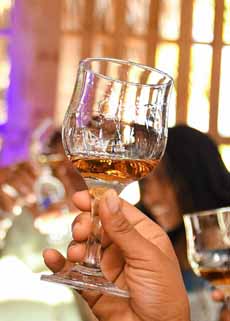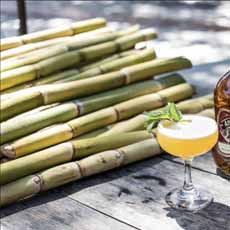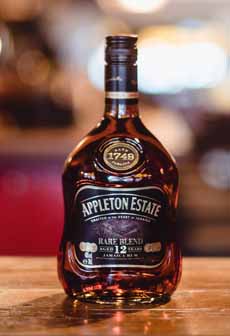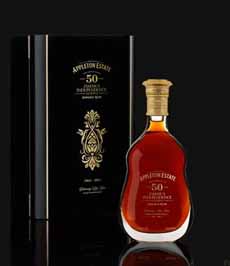PRODUCT: Rum’s The Word At Appleton Estates
|
How about a great bottle of rum for Father’s Day? Take a look at Appleton Estate rums, a line so fine that the brand doesn’t even make an unaged white/silver rum*. Most Americans have only known about rum since Prohibition, but in the Caribbean it’s been around since the 17th century. It’s light and cheerful, a cool refresher, and a great mixer. It’s also a smooth seducer, but can stoke you with a bit of fire too. Rum is a liquor of multiple personalities, as it should be: It’s a child of thousands of years of history, and quite a bit of world travel as well. Original wild sugar cane, native to Asia, made the rounds of New Guinea and Polynesia thousands of years ago, stopped off in ancient Persia where Alexander the Great picked it up for western Europe, and made a few stops around the Mediterranean, with the Crusades bringing it to Italy and Spain. Christopher Columbus laded his ship with the sweet stalks on his second voyage to the New World, dropping them off in the Dominican Republic. Since then, nearly every Caribbean island has cultivated sugar cane and the byproduct of its processed essence, molasses, from which rum is made. And who better to discover such a happy accident? The slaves brought from Africa to grow and harvest the sugar crops. Here’s more rum history. While every Caribbean country manufactures its own kind of rum, the end result can be quite distinct, with each region and each country having its own style of blending and aging. There are numerous styles of rum as well. Here are eight different rum styles. As with fine wines, sugar cane relies on terroir, weather variables, variety, and water purity. Because Jamaica’s terroir is rich in limestone, the water quality is particularly fine, as limestone is a natural purifier. During a March visit to Appleton Estate, the oldest and one of the largest producers of rum, we learned that Appleton alone grows some 14 varieties of sugarcane. Located near Kingston, the heart of Jamaica, conditions are perfect for growing, cooking, fermenting, and aging of what ends up as rum. Appleton Estate makes 5 expressions of rum, in increasing levels of age, complexity and smoothness (and price, ranging from about $25 to thousands of dollars for the 50-year): Here’s more about the different types of rum. There is rum, and then there is rum. White rum*, the clear version most of us are familiar with, is the punch-packer. It is labeled “Overproof” because it is 151% proof. If you don’t watch yourself, it’s easy to never know what hit you. White rum is, however, a terrific mixer in light, lively combinations of fruit juices and nectars, sodas, and lots of ice. A favorite Jamaican refresher is simply your preferred dose of white rum shaken up with Ting—a slightly not-too-sweet grapefruit soda—and lots of ice (you can buy it on Amazon). It’s cool company on a hot Jamaican evening. You would be hard put to find a Jamaican home that doesn’t have a bottle of white rum on hand—the country has some savvy uses for it† besides drinking. At the end of the spectrum are red rums (not in any way related to “The Shining”) that are aging now for Jamaica’s 100th Anniversary of Independence some 50 years from now. Aging takes place in previously used bourbon barrels that lend color, complexity, depth of flavor, and fire to what starts out as molasses. It is up to a Master Blender (at Appleton, she is the very brilliant Joy Spence, a chemist and designated Master Blender, appointed in 1997). All rums begin as sugar cane. It’s harvested by machete and stripped of its tough outer layer to reveal a semi-firm, highly sweet pulp. It’s great for chewing on its own when you need a hit of something sweet—just be sure to discard the pulp. (Cut into batons, the pulp also makes a sweet skewer for “Sugar Cane Shrimp,” made on the grill; or as a stirring stick for a rum cocktail.) Two pressings extract all of the liquid in each cane. This liquid is distilled with water and fermented but not aged, thus retaining a high alcohol content. The more complex aspects of rum that you taste in “red rum” come from boiling down the extracted liquid until crystals are formed and the liquid becomes molasses. The syrupy, rich reduction is then placed in a centrifuge where the sugar crystals separated from the molasses. The real magic of a delicious rum, though, happens through chemistry when it is distilled. |
|
|
|
At Appleton, red rums are aged for up to 21 years. The longer rum is aged, its color becomes progressively darker and the texture smoother, while the longer aging contributes a bit of fire (50 years is the limit in terms of barrel aging). Drinking a fine aged rum is similar to sipping a well-aged bourbon or whiskey. COOKING WITH RUM At Jamaica’s first-ever Rum Festival last March, which showcased commercial and independent rum makers and their products, we were lucky to meet Jamaica’s ebullient chef, event producer, and caterer, Jacqui Tyson. We asked her how she likes to use rum in cooking, and she regaled us with some intriguing suggestions for using white rum at home. She is never without rum in her kitchen—she will use it in jerk dishes, or to make curried goat—and calls it the “glue” that brings flavors together. *They do produce a line of white rums under the name of Wray & Newphew. †Consider these uses to be folk medicine.
|
||









